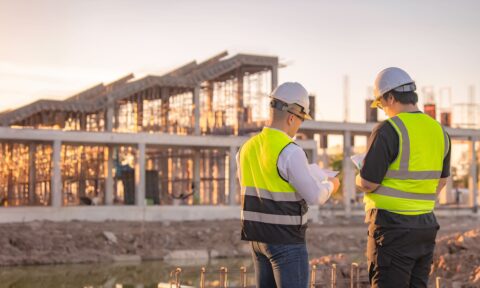Design of Earthquake Resistant Structures
- Course focuses on seismic design for safer infrastructures in earthquake prone areas.
- Participants learn about Eurocode 8 and risk analysis for structures.
- Engineers and scientists involved in onshore and offshore structures should attend.
- Lectures cover seismic hazard assessment, structural dynamics, and Eurocode 8 design.
- Instructors are experts in geomechanics, earthquake engineering, and bridge engineering.
Overview
The Online Earthquake Structures Training course aims to equip engineers and scientists with the necessary skills to design safer and resilient infrastructures in earthquake-prone areas. The course covers seismic design aspects, risk analysis of structures, and introduces Eurocode 8 guidelines. Participants will study various earthquake hazards, seismic analysis techniques, and design considerations for earthquake-resistant structures. The course is suitable for professionals involved in designing, operating, and assessing onshore and offshore structures. Expert lecturers from diverse engineering backgrounds provide in-depth knowledge and practical insights throughout the program.
Who should attend
Engineers, Scientists
Course Content
ABOUT THE COURSE
Today the global outreach of civil engineering is expanding and throwing new challenges for designers and engineers. Designing safer and resilient infrastructures in earthquake prone areas is increasingly becoming a key skill. It’s therefore essential for the personnel to understand the implications of seismic actions. This course aims to highlight the important aspects in seismic design. Risk analysis of structures indicate the point of failure and help in taking steps to mitigate this hazard. Introduction to Eurocode 8, emphasises the considerations for earthquake resistant design that is capable of resisting catastrophic failure. Earthquakes dominate design of many structures, see for example Nuclear Power Plant safety related structures or critical infrastructures (hospital, bridges) in moderately seismic zones.
Different types of earthquake hazards [Linear spatial structures, ground failure induced damages, predominantly structure related damages, case studies of cascading failures such as Fukushima Daiichi NPP] will be studied. Based on best practice and code compliance, the focus will be on the parameters required for design and interpretation of the specialised PHSA analysis. General rules, seismic actions, Different types of analysis, Response Spectra Method will also be dealt with.
WHO SHOULD ATTEND
Engineers and scientists involved in the design, operation and assessment of both onshore and offshore structures and their associated equipment. Personnel from oil companies, consultancy organisations, classification societies and certifying authorities will benefit from attending this course.
PROGRAMME
Day 1
08.30 – 09.00 Delegate Registration
09.00 – 10.30 Lecture 1: Introduction to Earthquake Engineering – Subhamoy Bhattacharya
10.30 – 10.45 Break
10.45 – 12.15 Lecture 2: Seismic Hazard Assessment [PHSA and DHSA] – Barnali Ghosh
12.15 – 13.30 Lunch
13.30 – 15.00 Lecture 3: Fundamental of Structural dynamics & Seismic analysis of Structures – Stergios Mitoulis
15.00 – 15.30 Break
15.30 – 17.00 Lecture 4: Selection of input motion for analysis based on codes of practice (ISO code and Eurocode). Example applications – Barnali Ghosh
Day 2
09.00 – 10.30 Lecture 5: Seismic Analysis based on Eurocode 8 [Concrete and Steel structures] – Stergios Mitoulis
10.30 – 10.45 Break
10.45 – 12.15 Lecture 6: Eurocode 8 Design of Bridges for earthquake loading – Stergios Mitoulis
12.15 – 13.30 Lunch
13.30 – 15.00 Lecture 7: Ground Response, Liquefaction Analysis based on Eurocode 8 and Japanese Code of Practice – Subhamoy Bhattacharya
15.00 – 15.30 Break
15.30 – 17.00 Lecture 8: Design of pile foundations in seismic areas (Theory and codes of practice), Example case studies – Subhamoy Bhattacharya
ABOUT THE LECTURERS:
Subhamoy Bhattacharya:
Professor Subhamoy Bhattacharya currently holds the Chair in Geomechanics at the University of Surrey where he leads the Geomechanics Research Group. He is also the Programme Director for the MSc course in “Advanced Ground Engineering/Advanced Geotechnical Engineering” and the Director of Undergraduate Studies in Civil Engineering. Previously, he held the post of Senior Lecturer at the University of Bristol, Departmental Lecturer at the University of Oxford and Academic fellowship at Tokyo Institute of Technology as well as industrial positions with Fugro Limited (UK) and Consulting Engineering Services (India) Ltd – now Jacobs. He obtained his PhD from the University of Cambridge, investigating failure mechanisms of pile-supported structures in liquefiable soils. He proposed a new theory on pile failure which received the 2005 T.K.Hseih award for the best paper in civil engineering dynamics from the Institution of Civil Engineers. His further work on piles includes design principles for the foundation design of new generation Floating Production Storage and Offloading platforms, built from his experience designing piles for more conventional offshore structures. His work on p-y curves for clay appears in the latest API/ANSI/ISO code of practice. His current research interest are foundations for offshore wind turbines, seismic behaviour of piles.
Barnali Ghosh
Dr Barnali Ghosh is a Senior Principal Engineer at Mott MacDonald (London). She has experience of civil, geotechnical and earthquake engineering. She is a chartered civil engineer having 17 years’ experience of designing foundations in seismic areas all over the world She is responsible for all aspects of geotechnical earthquake engineering and soil dynamics in Mott Macdonald’s London office. She has carried out both regional and site-specific geotechnical and seismic hazard assessments for a range of structures in the energy, infrastructure and manufacturing sectors. She has extensive experience of determining dynamic soil properties for seismic design, seismic hazard assessment, non-linear site response analyses, the latest liquefaction assessment methodologies and dynamic soil structure interaction. She has acted as a reviewer for numerous projects all around the world. She has worked extensively in projects based in UK and oversees and understands the code requirements for seismic design. Dr Ghosh has also published her work extensively and associated with several committees and actively lectures about earthquake geotechnical engineering. She is a committee member for SECED (Society for Earthquake and Civil Engineering Dynamics) and is an honorary lecturer at University College London where she teaches earthquake engineering. Her motivation is to build resilient infrastructure.
Stergios Mitoulis
Dr Stergios Mitoulis is Lecturer of Bridge Engineering at the University of Surrey. He leads a research group (www.mitoulis.com) that focuses on resilient bridge engineering, earthquake engineering and soil-structure interaction. He has worked and he is still an active consultant of design offices and Highways Agencies and research centres on antiseismic designs. Dr Mitoulis graduated with a 5-year Diploma in Structural Engineering from the Department of Civil Engineering of Aristotle University of Thessaloniki in 2002. He subsequently received an MSc on the Seismic Design of Structures in 2003. In the same year, he started his doctoral studies funded by the Research Excellence Framework (REF) of the Research Committee of Aristotle University. He finished his doctoral studies in 2007. He continued with a 2-year postdoctoral research on innovative construction methods of earthquake resistant bridges, funded by the REF of Research Committee of Aristotle University of Thessaloniki. Dr Mitoulis has broad experience on the numerical modelling, analysis and experimental testing (shake table tests) of structures subjected to seismic loads. He has participated in more than 10 research projects on the seismic design and rehabilitation of bridges and buildings. He has authored two and co-authored another 15 journal papers, and more than 40 conference papers and three book chapters on the seismic design, retrofitting, cost-effectiveness and isolation of bridges and elastomeric bearings. Dr Mitoulis is an EU Chartered Civil Engineer since 2002 and he has gained design experience developing projects for reinforced concrete structures including new buildings, a pedestrian bridge, assessment, retrofitting and strengthening of R/C structures for seismic loads. He worked as a consultant engineer for Egnatia Highway bridges on the seismic design and cost-effectiveness of highway bridges. He is a member of the UK’s Eurocode 8 Mirror Group, who will be working on the revisions to Eurocode 8-2. He is a member of the European Association for Earthquake Engineering (EAEE) and a member of the International Association for Bridge and Structural Engineering (IABSE).
Lecture Content
Lecture 1: Introduction to Earthquake Engineering
Different types of earthquake hazards [Linear spatial structures, ground failure induced damages, predominantly structure related damages, case studies of cascading failures such as Fukushima Daiichi NPP].
First fundamental concepts of earthquake engineering are introduced i.e. the way earthquakes are generated and how forces are experienced by the structure i.e. seismic wave propagation. Although this is the subject of an entire different discipline, the description is kept brief and is used to provide the necessary link between the earthquake cause and the effects and how to consider this in earthquake resistant design
Lecture 2: Seismic Hazard Assessment [PHSA and DHSA]
Based on best practice and code complaint. The focus will be on the parameters required for design and interpretation of the specialised PHSA analysis.
Introduces the hazard assessment i.e. quantification of the hazard. This will mainly constitute PSHA (Probabilistic Seismic Hazard Assessment) and the outputs of the analysis are the necessary input to the structural and Geotechnical Engineers. One of the aspects is interpretation if the PSHA results which will be covered in this lecture. Example problems will be taken.
Lecture 3: Fundamental of Structural dynamics & Seismic analysis of Structures
General rules, seismic actions, Different types of analysis, Response Spectra Method
Fundamental structural dynamics will be discussed in a generic way, with earthquake loading forming a special case of loading. Modal analysis will
be covered (Single degree of freedom systems to multi-degree of freedom structures).
Lecture 4: Selection of input motion for analysis based on codes of practice (ISO code and Eurocode). Example applications
This lecture will cover the methods of selecting input motion for seismic design. Special emphasis will be focussed on areas where ground motions may not be available. Additional criteria for selection of ground motion will be discussed.
Lecture 5: Seismic Analysis based on Eurocode 8 [Concrete and Steel structures]
Dynamic analysis techniques that are commonly used to determine the response of structures due to random (seismic) loading. The concept of frequency domain and time domain techniques are studied, and how these analyses should be used for subsequent assessment and design, following both EC8 procedures. The use of finite element analysis to determine structure response to a seismic input will also be addressed.
Lecture 6: Eurocode 8 Design of Bridges for earthquake loading
This lecture deals with methods to analyse bridge
Lecture 7: Ground Response, Liquefaction Analysis based on Eurocode 8 and Japanese Code of Practice
Ground response analysis including liquefaction susceptibility i.e. how the ground alters the ground motion characteristics will be studied.
Lecture 8: Design of pile foundations in seismic areas (Theory and codes of practice), Example case studies
Covers design of foundations in seismic areas based on Eurocode 8 (Part 1 and Part 5).
Cost:£595 + VAT
Duration: 2 Days
Online Earthquake Resistant Structures Training
Virtual Earthquake Resistant Structures Training
Earthquake Resistant Structures Online Training Course
Earthquake Resistant Structures Virtual Training Course



